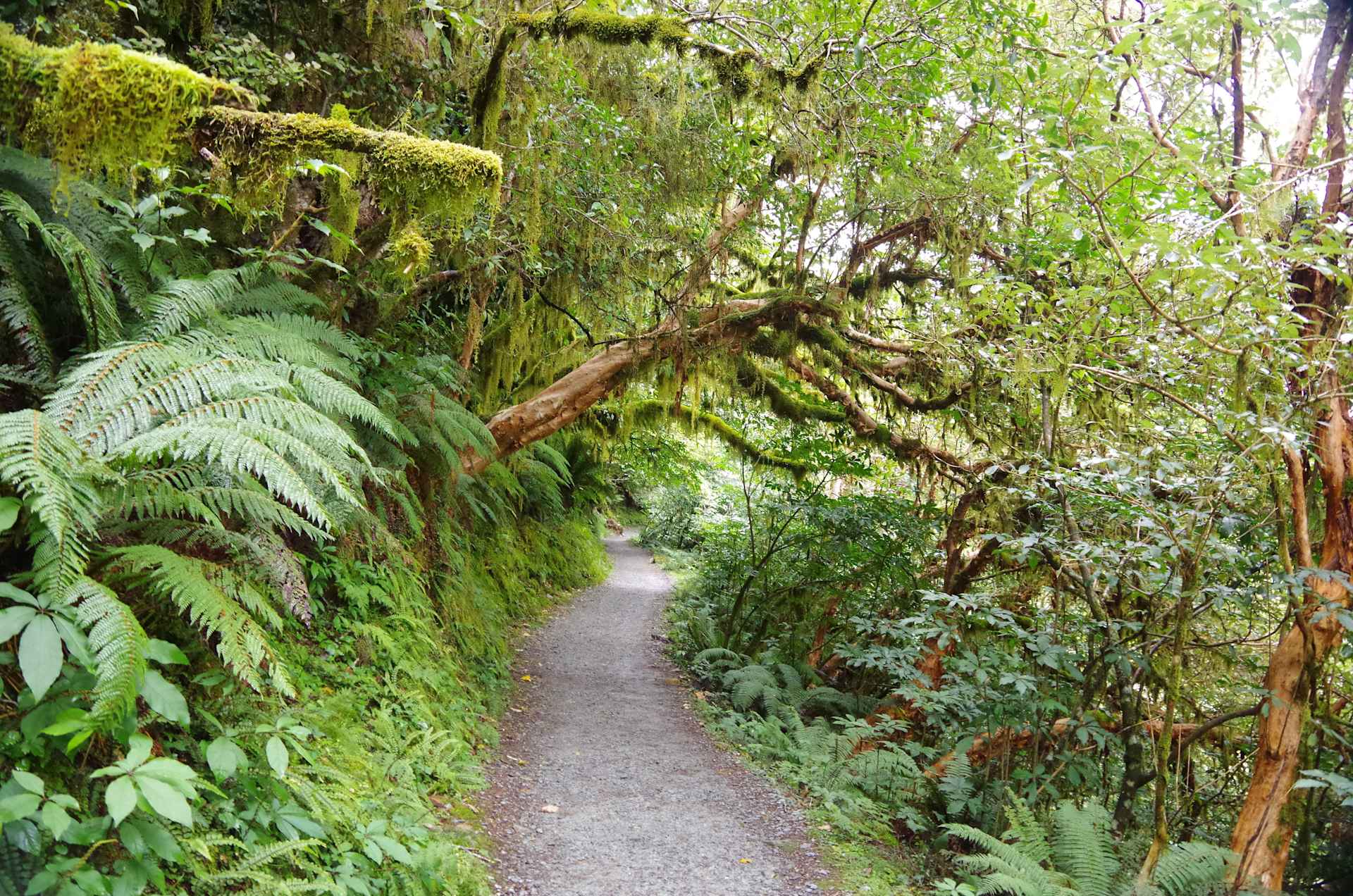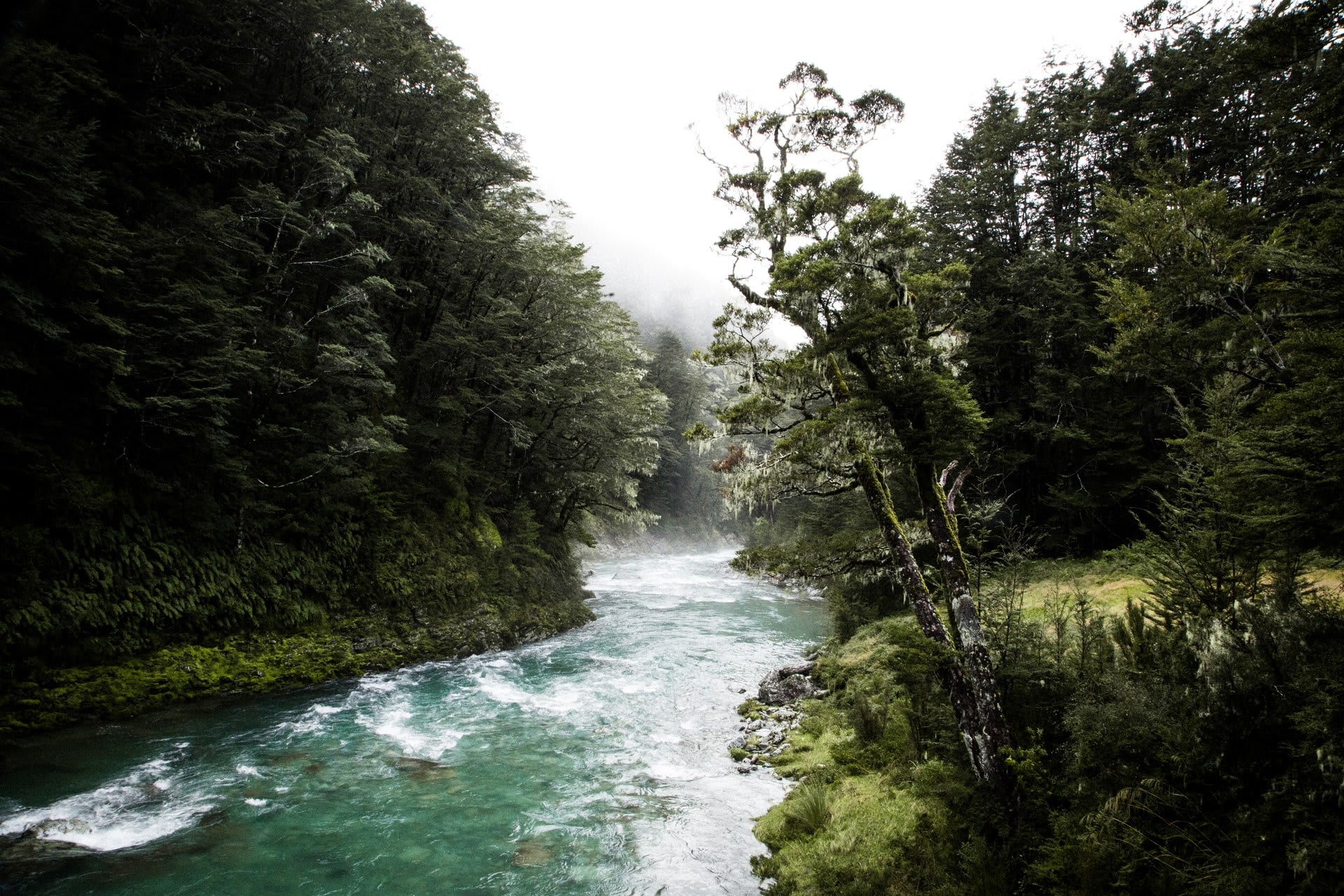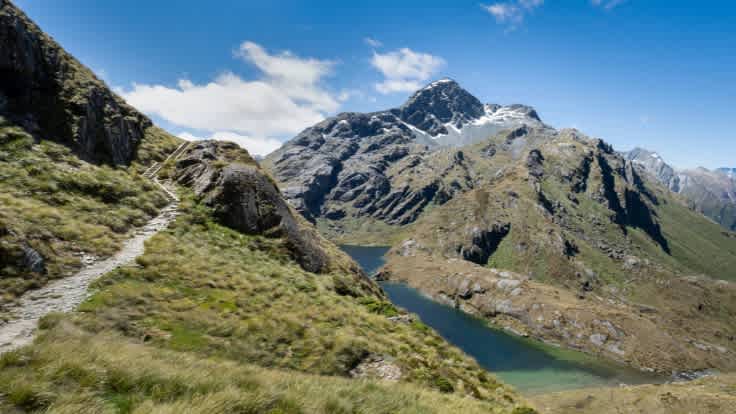
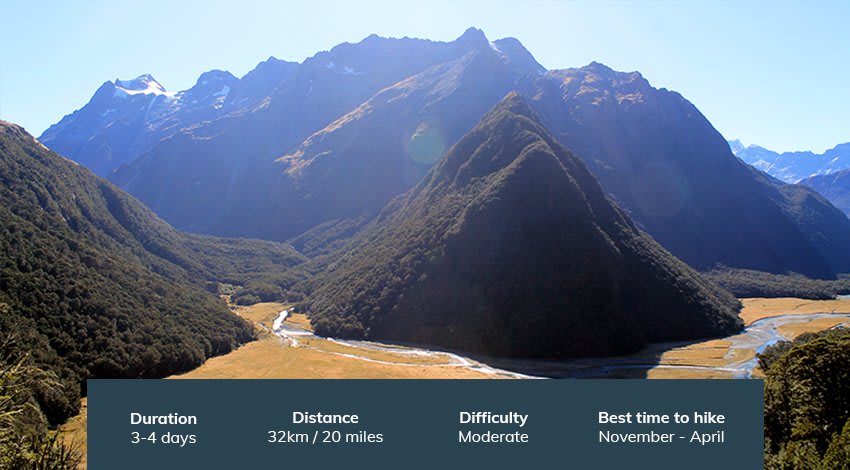
The Routeburn Track, New Zealand
The Routeburn trek is a 33km hike within Mount Aspiring and Fiordland National Parks. The vast wilderness is part of the Te Wahi Pounamu, South West New Zealand World Heritage Area. Below you can find the key information about the Routeburn Track: where the Routeburn starts and how to get there, how long it takes to hike the Routeburn and when is the best time to hike, where to find the Routeburn Track Huts plus the Routeburn Trail Map and a word on trail etiquette.
Location: Where is the Routeburn Track?
The Routeburn Track is located in the south-west of the South Island and runs between the head of Lake Wakatipu and S.H.94 the Te Anau /Milford Road. Drive times to Queenstown or Te Anau are: 1 hour 45 minutes from Invercargill; 3 hours 30 minutes from Dunedin and 6 to 8 hours from Christchurch.
One start/finish point of the track is the Routeburn Shelter, at the Mount Aspiring National Park end of the track. It is 72km (1 hour 10 minute drive) from Queenstown via Glenorchy and there is a car park. The Divide, at the Fiordland National Park end of the track is the other start/finish point and again there is a parking lot. It is 85 km (1 hour 20 minute drive) from Te Anau on the road to Milford Sound S.H 94 or 36km (30 minute drive) from Milford Sound. It is two hours by road between Queenstown and Te Anau.
As this track is not a circuit track, plan your return transport options. Bus companies departing daily from both Te Anau, Queenstown and Glenorchy service both ends of the track. A list of these operators appears with the application form. During the winter season there is no regular transport services to and from the track and walkers must organise all transport prior to departure for the track.
Hikers can purchase Routeburn Track trail maps from Glenorchy or Queenstown DOC HQ.
Routeburn Track Map
Weather on the trail: When is the best time to hike the Routeburn Track?
The best time of the year to hike in the Routeburn is during the hiking season, from late October to late April. October and November daily highs are around 14 degrees Celsius (62-66 F), and alpine flowers bloom all around. December to February are warmer and dryer but also busier, and daily highs around 19 degrees Celsius (70-73 F). Finally, April to May daily highs sit between 15 degrees Celsius (60-64 F) and the trail is a bit more quiet. Fiordland and Mt. Aspiring National Parks have high rainfall and changeable weather. Be prepared for at least one wet day on your trip. Remember, exposure / hypothermia can affect anyone when the weather is wet, cold and windy.
During the winter season (late April to late October) snow and avalanche danger can make the track impassable in some of the alpine sections. Please check current track and weather conditions at the Glenorchy or Fiordland National Park Visitor Centres before departing on the track.
Fitness: How fit do you need to be to hike the Routeburn Track?
Any fit person can walk the Routeburn Track. You will need to be able to carry all your own gear over rough rocky uneven surfaces, climbing and descending for up to 12 kilometres (7.5 miles) a day with a maximum elevation gain of 600 metres (1,970 feet). It's an ideal trip for groups or individuals. You should start a regular walking programme 1-2 months before your departure on the track. This programme should include some practice at carrying your pack on hills or stairs. The track can be walked in either direction and in conjunction with the Greenstone and Caples Tracks. You can walk the whole track or walk into one of the huts and return the same way, spend a single night at one of the huts; or stay up to two nights at each of the four huts or two campsites. The choice is yours.
It is recommended that children under the age of ten do not attempt the alpine section.
Make sure all of your party is capable of undertaking the planned trip, are fully equipped and prepared for all weather conditions.
For those not wishing to walk the whole track, Lake Howden and Routeburn Flats huts are ideal for a one-night Routeburn experience.
Accommodation and facilities on the Routeburn Track
Routeburn Track Huts
There are four Department of Conservation huts on the track - Routeburn Flats, Routeburn Falls, Lake Mackenzie and Howden Huts.
In the winter season huts are supplied with tables and benches, water supply, stove for heating in main hut and pit toilets. In the booked walking season tables, benches, lighting, heating, cold running water and gas cooking rings are supplied in the main hut. Ablution blocks have flush toilets and wash basins. In both seasons walkers sleep in communal bunkrooms, mattresses provided - no lighting or heating.
Conservation staff are in residence over the booked walking season. They are equipped with radios for use in emergencies and for weather forecasts. Staying overnight in the shelters is not permitted on the Routeburn Track, and facilities for guided walkers are not available to independent walkers.
Campgrounds
There are only two sites on the track where camping is permitted: Lake Mackenzie and Routeburn Flats. The campsites have a cooking shelter, water supply and pit toilet. Campers are not permitted to use the hut facilities.
Toilets
Please use toilets at huts and shelters. If this is not possible bury toilet waste well away from watercourses. Remember drinking water at huts and shelters comes from rivers and lakes.
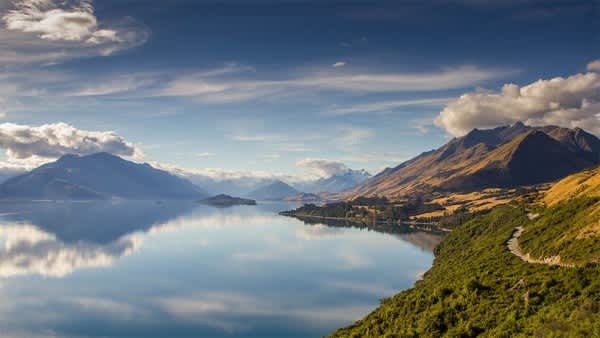
Road to the Routeburn Track from Queenstown
Track etiquette and how to prepare
Travel Insurance
We recommend you arrange travel insurance to guard against loss of costs associated with cancellation or delay of your trip. The Department of Conservation will not be liable for injury, damage or any costs incurred by intending walkers. Emergency evacuation from the track can only be arranged by Conservation staff. For your own safety please sign hut books when you arrive. Know the symptoms of exposure. React quickly by finding shelter and providing warmth. If you become lost, stop, find shelter, stay calm and try to assist searchers.
Please remember when trekking in New Zealand
- All plants, birds and animals in the park are protected
- Please carry your rubbish out of the park
- No dogs or domestic pets are allowed
- Hunting is by permit only. Permits can be obtained from the Department of Conservation
- Fire is a major threat. Fires should only be lit in designated fireplaces. Please make sure fires are extinguished properly before you leave, and use portable stoves for cooking.
- Smoking is not permitted in the huts and shelters.
- Wasps and sandflies can be a problem. Carry insect repellent and antihistamines in case of allergy
- Possums are a pest and damage native trees. Do not encourage them by leaving food outside overnight
How to book the Routeburn Track
Going by yourself
Booking is essential to guarantee your hut or campsite between November and late April. Outside this time during the winter season no bookings can be made and tickets for huts can be purchased from the Department of Conservation Visitor Centres just prior to departure. Bookings can be made on the DOC website from June 10 each year for the coming summer season. There is a two-night limit on staying at each hut and campsite.
The booking system assures you of a bunk for the night. It avoids the need to rush to get to huts early to get a space or to carry a tent in case you miss out. You can walk and enjoy the track at your own pace.
Going guided
If you find the accommodation for the Routeburn Track is sold out due to high season popularity, dont' worry, it's not the end of the road. You can still join a Great Walks guided tour. Many of our trips, such as our Ultimate South Island Adventure or Great Walks of New Zealand include a day walk at either end of the Routeburn Track including the best sections of the trail, plus a sample of many other Great Walks like the Milford Track and Kepler Track.
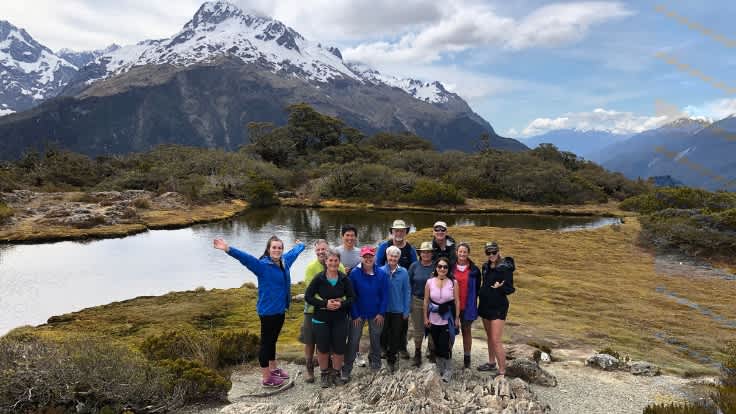
Detailed Itinerary
Times are approximate only and will vary according to fitness and the pace of your group.
The track can be walked in either direction and in conjunction with the Greenstone and Caples Tracks. You can walk the whole track or walk into one of the huts and return the same way, spend a single night at one of the huts; or stay up to two nights at each of the four huts or two campsites. The choice is yours.
This Guide describes the track from east to west but it can just as easily be walked in the opposite direction from the Divide to the Routeburn Shelter.
The Routeburn Track can also be linked with the Greenstone or Caples Tracks. No bookings are required for either of these tracks. Bookings can not be made for the Greenstone or Caples Tracks - tickets need to be purchased from a department of Conservation visitor centre just prior to departure and walkers will need to carry a gas cooker.
Routeburn Shelter to Routeburn Flats Hut - 6.5km, 2 to 3 hours.
From the car park at the Routeburn shelter (458m) cross the swing bridge onto the well formed, easily graded track as it rises though red, silver and mountain beech forest. Past Sugarloaf Stream the track is a remnant of the old bridle path built in the 1870s and climbs directly to Bridal Veil Stream. The track then sidles above the Routeburn Gorge. A second swing bridge takes you back across the Routeburn River to the open grassed flats around Routeburn Flats Hut. Routeburn Flats Hut has 20 bunks and a camping area 5 minutes from hut.
Routeburn Flats Huts to Routeburn Falls Hut - 2.3km, 1 to 1.5 hours
This is a steady climb through beech forest crossing two swing bridges. The Emily Creek bridge is considered to be the halfway mark. Beware at this point as early and late season avalanches can fall as far as the bridge. Routeburn Falls Hut has 48 bunks.
Routeburn Falls Hut to Lake Mackenzie Hut - 11.3km, 4 1/2 to 6 hours.
This sub-alpine section of track is very exposed and can be extremely hazardous in adverse weather conditions - be sure that you heed the advice of conservation staff in such conditions.
The track climbs steadily, following the Route Burn to its outlet from Lake Harris. A steep sidle through moraine and the bluffs above Lake Harris finally leads to the Harris Saddle/ Tarahaka Whakatipu (1255m) and the shelter. The shelter is available for day use only. Allow one or two hours for the climb. Sub-alpine herbs and cushion plants are a feature of the vegetation. These areas are very fragile so please keep to the track. A short climb from the Harris Saddle up Conical Hill gives superb view of the Hollyford Valley through to Lake McKerrow, Martins Bay and the Tasman Sea. Allow 1 to 2 hours for the return trip. From the saddle the track drops steeply down a gully and traverses along the exposed Hollyford face before descending onto a series of zigzags leading down to Lake Mackenzie Hut. Allow 3 to 4 hours for the descent from the saddle. Lake Mackenzie Hut has 48 bunks and 9 campsites 5 minutes from the hut.
No camping is permitted between Routeburn Flats and Lake Mackenzie.
Lake Mackenzie Hut to Lake Howden - 8.6km, 3 to 4 hours
The track crosses a small flat before climbing steeply at first until the bushline is reached. The track gradually descends past the 'Orchard', an open grassy area dotted with ribbonwood trees, to the Earland Falls. An emergency bridge is situated down stream should the falls be in flood. The track continues its gradual descent to Howden Hut, situated at the junction of Routeburn and Greenstone/Caples tracks. A campsite is situated at the Greenstone saddle 20 minutes down the Greenstone Track. Lake Howden Hut has 28 bunks.
Lake Howden Hut to The Divide - 3.4km, 1 to 1.5 hours.
The track climbs for about 15 minutes to the Key Summit turn-off. From the turn-off the gradual downhill walk to The Divide is through silver beech forest. The Divide (532m) is the lowest East/West crossing in the Southern Alps.
Overnight use of the Harris Saddle Shelter and track-end shelters is not permitted.
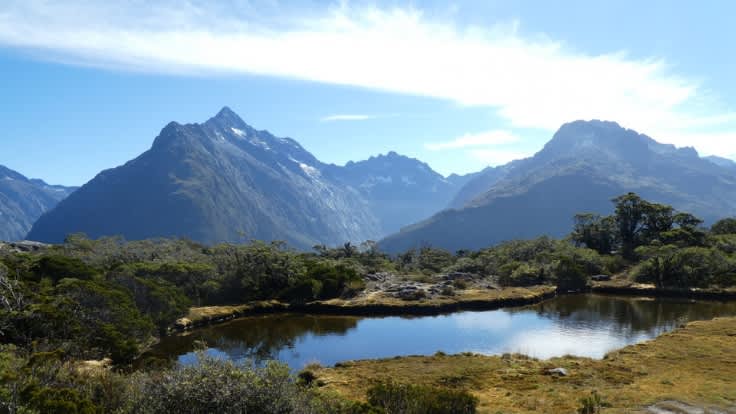
Gearlist: What you need to pack
For your own safety it is essential to carry the equipment listed below, no matter how warm it is on the day of departure:
Most equipment is available for hire or purchase in Queenstown and Te Anau, as well as a full range of food. Basic stores are available in Glenorchy and Milford Sound, but with limited variety.
Clothing
- You will need at least one set of clothes to walk in, and another dry set to change into at night. It is not possible to dry clothes overnight in the huts.
- Boots: need to be comfortable and well broken in.
- Socks: (wool/polypropylene) 2 pairs
- Shorts: (cotton/ nylon)
- Shirt: (wool/polypropylene)
- Long Johns or trousers: (wool/polypropylene)
- Jersey or Jacket: wool/polypropylene)
- Undershirts/ T-shirt: (wool/polypropylene)
- Mittens/Gloves: (wool/polypropylene)
- Woollen hat /balaclava & sun-hat
- Raincoat: (waterproof, windproof with hood)
- Extra socks, underwear, shirt or lightweight jersey.
- Warning - synthetic clothing is flammable.
- It is essential that this clothing is carried as your safety and the safety of others could depend on it.
- NB: cotton clothing such as jeans, T-shirts, sweatshirts are NOT suitable.
Personal Equipment:
- Pack: with large waterproof liner
- Sleeping Bag: good quality down or hollofil
- Matches/ Lighter: in waterproof container
- Torch: spare batteries
- Eating utensils: Knife, fork, spoon, plate, and cup
- Cooking utensils: pot/pan/billy, pot scrubber
- Toilet gear: soap, toothpaste, toilet paper, small towel (remember do not wash in lakes or streams)
- First Aid Kit: insect repellent, sunscreen, blister kits, pain relief, and assorted bandages
- Survival Kit: Survival blanket, whistle, paper, pencil and spare days food.
- Drink bottle: you need to drink regularly during day
- Optional extras: sunglasses, camera, and lightweight shoes for in hut, earplugs for communal bunkrooms
- Campers need to carry gas cookers, tents and bedrolls. Campers are not permitted to use the hut facilities.
- Outside the booked walking season walkers will also need to carry gas cookers and mountain radios.
Food
- Is not available for purchase on the track.
- Food should be lightweight, fast cooking and high in energy value e.g.
- Breakfast: cereal, firm bread, honey or other spreads
- Lunch: cracker biscuits, cheese, salami, margarine, jam/jelly, powdered fruit drink, fruit
- Dinner: instant soup, pasta/rice, dried vegetables/fruit, cheese or dehydrated (freeze dry) meals.
- You will also need: snacks, biscuits, muesli bars, tea/coffee, powdered drink, emergency food in case of any delays on the track.
Water
You will need to drink regularly while walking, even on cooler days, to avoid dehydration. You need to carry some water, as you may not be able to find any enroute. Giardia may be present in some areas. Regular testing is not carried out. If you wish to treat the water you can boil water for 5 minutes, use a filter, or chemically treat it. Drinking water at the huts and shelters comes from the rivers and lakes.
A bit of extra background about the Routeburn Track
History of the Routeburn
In pre-European times, Maori people frequently used this route during journeys searching for pounamu, or greenstone - which was much valued as a material for tools, weapons and ornaments.
The first Europeans to view the Hollyford Valley were Southland runholders David McKellar and George Gunn, who on June 9, 1861 climbed to the top of Key Summit via the Routeburn.
Early European surveyors, prospectors and explorers travelling from Lake Wakatipu to the Hollyford River and western valleys subsequently used the route.
In 1870 a bridle track was started to link Kinloch and Routeburn with the new Martins Bay settlement. However, failure of the isolated settlement and incorrect routing of the road meant construction ceased after four years. Tourism began in the 1880s, with visitors being taken into Routeburn Flats by horse and then guided on foot to the Harris Saddle.
Flora and Fauna: What to look for on the Routeburn Track
The track follows close to a major fault zone which has thrown together both metamorphic and sedimentary rocks.
During the Ice Ages, the last of which ended some 10,000 years ago, huge glaciers carved out the rock. The Hollyford glacier was so large it curved around the southern end of the Darran Mountains and flowed 50 kilometres north to Martins Bay. It overtopped the main divide at Key Summit and two lobes flowed to the south - one to Lake Wakatipu via the Greenstone Valley and the other to Lake Te Anau via the Eglinton Valley. When the glaciers retreated they left the distinctive U-shape main valleys, smaller hanging valleys, cirque basins and residual glaciers like Donne Glacier on the eastern face of Mt. Tutoko.
Beech is the dominant forest tree, with red beech around the start of the Routeburn Valley on sunny, frost-free sites. Mountain beech occurs at higher altitudes within the Routeburn Valley. Silver beech competes best on the wetter Hollyford faces along with broadleaf and fuchsia. A feature of the beech forest is the abundance of ferns, mosses, lichens and perching plants.
The track passes through several avalanche paths colonised by ribbonwood; one of New Zealand's few deciduous trees.
Above the bushline between Lake Mackenzie and the Routeburn Falls are snow tussock grasslands, and herb fields with mountain buttercups, daisies, and ourisias. Bog communities with sundews, bladderworts (Utricularia, commonly and collectively called the bladderworts, is a genus of carnivorous plants consisting of approximately 233 species), orchids, daisies and bog pine occur around tarns on Key Summit.
Riflemen, bellbirds, robins, yellow crowned parakeets, yellowheads, tomtits, fantails, kaka and wood pigeons are common bush birds. Towards evening, native bats and moreporks (small owls) may be seen and heard. Blue ducks and paradise ducks live in the valley. In the sub-alpine zone look out for rock wrens, New Zealand falcons and the mischievous mountain parrot, the kea.
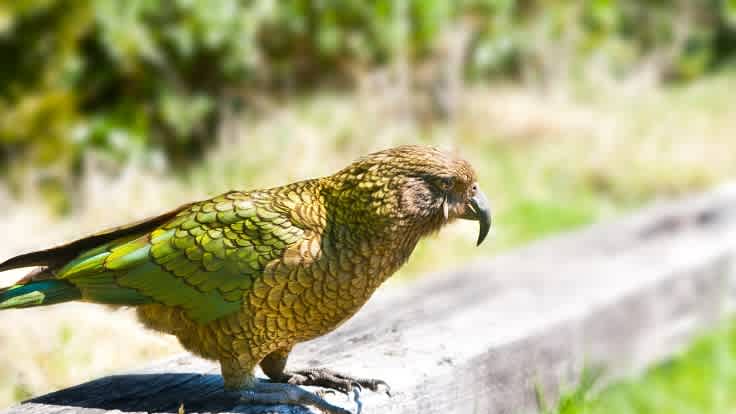
The mischievous mountain parrot, the Kea
Introduced animals include whitetail deer in the lower Routeburn valley, red deer throughout the forested areas and chamois about the mountaintops. Possums, hares, rats and stoats are widespread. Hunters require a permit before entering the parks.
Introduced brown and rainbow trout are found in the lower Route Burn and brown trout are present in Lake Howden. Anglers must hold a current fishing licence.
